
Wine Culture and Information since 2002 - Volume 22
 Wine Culture and Information since 2002 - Volume 22 |
|
Comparing Nebbiolo and MerlotGrapes with an extremely different character, emblem of two distinct and opposed sensorial worlds, both however capable of making wines of recognizable personality |
|
This month's comparative tasting can be seen as a sort of clash between two giants representing two different worlds as well as two enological cultures of opposing nature. Nebbiolo, indisputable symbol of Piedmont's Langhe and of Lombardy's Valtellina, is famous for its powerful and strong wines, characterized by a remarkable acidity. Merlot, a grape originating from the Bordeaux area, is virtually found in every wine making country of the world, it is famous for pretty opposite qualities. Even Merlot is capable of making wines of remarkable body, however, as opposed to Nebbiolo, its character is round and soft, with non aggressive tannins. Different grapes making different wines, protagonists of two different styles of wine making and, despite of their different characters, the two grapes have met in the bottle. In the Langhe area, for example, they make red wines in which the roundness of Merlot is used to soften the typical strength of Nebbiolo.
|
Nebbiolo undeniably is one the most renowned grapes of Piedmont and of Italy. This grape is also found in other areas of Italy, of which the most representative one is Valtellina, in Lombardy, area in which the grape is known as Chiavennasca. In recent times, also in Valtellina they prefer to call this grape Nebbiolo. Late ripening grape, harvested in vineyard when all the other varieties are fermenting in winery already, Nebbiolo takes its name from the fact it finishes ripening with the arrive of fog (nebbia in Italian). This grape is not an easy one, in particular when it is poured in a glass, Nebbiolo it is not a “in between grape”: you love it, or you dislike it. Wines produced with this grape, despite they give different results according to the production area - a consideration true, of course, for every grape - are all characterized by an evident astringency and a strong acidity. Many are in fact disoriented by these two qualities, as they indisputable make Nebbiolo wines more complex and less immediate. Its “harsh” characteristics, force the wine maker - like to say - to age the wine in cask, in order to round its harshness while making the wine more balanced. In the areas in which Nebbiolo is traditionally found, the most frequent choice is in favor of large casks, although in relatively recent times the barrique has been widely used as well. This type of choice, of course, greatly affects the final result, not only the type of tertiary aromas the wine can develop, but also the aging times. Last but not the least, it is also a matter of “taste” and of expression of the wine. Whether in the barrique the wood character is more evident, the aging in large cask, although giving the wine tertiary aromas, allow the wine to express elegance as well as the fruity qualities of Nebbiolo.
|
||||||||
|
Merlot certainly is one of the most famous grapes in the world. Its fame is such today it is virtually found in every wine making country of the world, and it used to make mono varietal wines as well as blended with other varieties, not only autochthonous grapes. Indisputable representative of roundness and softness, Merlot - according to the use made in wine making - quickly conquered the favor of many wine lovers. This should not however make the grape considered as a simple one, as with this grape are made wine of remarkable elegance and class. Thanks to its qualities, Merlot is frequently used for correcting those wines which, when tasted, would be excessively “hard” and, in this sense, Merlot is capable of making miracles. We could consider Italian wine scene, for example: in many wines produced by assembling wines produced with different grapes, Merlot is found in many of them. Merlot makes great wines in particular when used alone. Grape suited for the fermentation and aging in barrique - that is the typical cask originated from its homeland Bordeaux - despite this is the most common style, Merlot has also proven to make excellent wines vinified in steel tanks. However, wines produced with Merlot, also in the most complex and rich examples, have the characteristic of being very direct and agreeable, in particular for the presence of non excessively aggressive tannins and a charming roundness. These qualities have in fact allowed Merlot wines to be very successful among consumers, also thanks to the modern trend of taste which likes roundness and flavors which, for different reasons, tend to the reassuring immediacy of sweetness. Merlot is however a very versatile grape, with which are being produced many styles of wines, from “simple” ones to wines with remarkable body, from immediate ones to extremely complex ones.
|
||||
|
The goal of this comparative tasting is to understand the difference between contrasting organoleptic qualities. For this reason we have chosen wines produced with grapes having truly different qualities, almost opposite, in order to make the differences evident. The first wine we will examine is Conti Sertoli Salis' Valtellina Superiore Corte della Meridiana, produced with 100% Nebbiolo and allowed to age for 18 months in cask. The second wine is Castello delle Regine's Merlot, produced with 100% Merlot and aged for 24 months in barrique, a frequent choice for wines produced with this grape. The wines will be chosen according to the vintages currently commercialized by respective producers. The tasting will be done - as usual - in two ISO tasting glasses and the wines will be served at the temperature of 18°C (65°F).
|
|
Merlot and Nebbiolo are very different grapes and the differences are evident beginning from the aspect. Nebbiolo does not have a high content in coloring substances and its wines are generally characterized by a moderate transparency. Merlot has a high content in coloring substances, a quality that in its wines is witnessed by a generally low transparency. Also the color is quite different. Whether in Nebbiolo can be seen - in youth - intense and brilliant colors, showing a ruby red hue, in Merlot can be noticed deeper and darker colors. Also nuances show evident differences: in Nebbiolo can be appreciated - also in youth - nuances tending to garnet red, whereas in Merlot is frequent a ruby red color. With aging the color in both wines usually follow the normal development of red wines, however in Merlot the low transparency tends to have a longer duration in time. The first wine of which we will examine appearance is Conti Sertoli Salis' Valtellina Superiore Corte della Meridiana. By holding the glass tilted on a white surface - a sheet of paper is enough - we will observe the wine at the base of the glass, at the point of greatest thickness. We will observe a brilliant and ruby red color, in which can be noticed a moderate and however evident transparency. The nuance in this wine, observed at the edge of the glass towards the opening, shows a garnet red color. Let's now pass to the analysis of Castello delle Regine's Merlot. The color of this wine, observed at the base of the glass, shows an intense and deep ruby red color, with an evident lower transparency than Valtellina Superiore. Also the nuance shows a ruby red color, intense and deep.
|
|
Differences between Nebbiolo and Merlot continues to the nose as the wines produced with these grapes offer pretty diverse aromas. The differences depend not only by the specific qualities of the grapes, but also by the way they are vinified in the winery and, in particular, by the characteristics of the containers used for aging. Whether for Nebbiolo is mainly used the cask, in Merlot the choice is frequently in favor of the barrique, therefore developing quite different tertiary profiles. Also the aromatic profile of flowers and fruits has a quite different impact. Whereas in Nebbiolo it is frequent to find red and black berried fruits, in Merlot are frequent aromas recalling black berried fruits only. This difference can also be found in aromas recalling flowers. Both in Nebbiolo and in Merlot can be perceived the aroma of violet, whereas flower aromas like cyclamen and rose can be perceived in Nebbiolo only. Let's start the evaluation of olfactory profiles from Conti Sertoli Salis' Valtellina Superiore Corte della Meridiana. By holding the glass in vertical position and without swirling, we will do the first smell in order to appreciate the opening aromas of the wine. From the glass will be appreciated aromas of cherry, plum, violet and raspberry, a pretty typical opening for wines produced with Nebbiolo grape. After having swirled the glass, the olfactory profile is completed by blueberry, rose and cyclamen, as well as complex aromas of vanilla, tobacco, cocoa, cinnamon, licorice and a fresh balsamic aroma of menthol. Let's now pass to the evaluation of Castello delle Regine's Merlot. The opening aromas are very different from Nebbiolo: here can be perceived black currant, black cherry and plum. After having swirled the glass, the olfactory sequence of the wine is completed by blueberry, violet, tobacco, vanilla, chocolate, mace and a pleasing balsamic touch of eucalyptus. Now compare the different impact of tertiary aromas produced by cask and barrique, as well as the differences in fruit and flower aromas.
|
|
The contrast between Nebbiolo and Merlot continues to the gustatory analysis as well. Impetuous and grumpy the former, accommodating and affable the latter, wines produced with these grapes have the common quality to have a structure that in some cases can be defined as robust. The tasting of wines produced with Nebbiolo and Merlot offer totally different organoleptic profiles. The attack of Nebbiolo is characterized by an evident crispness and astringency, also in case the wine was aged in the barrique. The attack of Merlot is characterized by a greater roundness and softness, with a less strong astringency, although evident. In both cases the alcohol by volume can be more than 13.5%. In wines produced with Nebbiolo, alcohol is useful in balancing both acidity and astringency, whereas in those made from Merlot, its effect is useful in balancing the astringency produced by the aging in wood. The first wine of which we will examine the gustatory profile is Conti Sertoli Salis' Valtellina Superiore Corte della Meridiana. The attack of this wine shows the strong character of Nebbiolo: in the mouth is perceived the characteristic crispness given by acidity as well as the power of tannins. These sensations are then replaced by the effect of alcohol and the perception of a robust structure. The correspondence to the nose is excellent, in particular with cherry, plum and raspberry. Let's now pass to the tasting of Castello delle Regine's Merlot. The attack of this wine is totally different from the previous one. The sensations this wine give the mouth are rounder and smoother: tannins - although present and thick - are not harsh like the ones in the first wine and here acidity is almost imperceptible. Roundness is also accentuated by the effect of alcohol, which also contributes to the balance of astringency. Also in this wine, the structure is pretty robust. Finally, compare the impact of wood in each wine and the taste-olfactory sensations of the respective sensorial profiles.
|
Wines of the Month |
|
|
|
Score legend Prices are to be considered as indicative. Prices may vary according to the country or the shop where wines are bought |
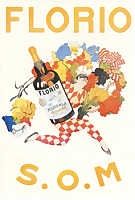
|
|
Marsala Superiore Riserva Targa Florio 1840 Edizione Speciale 170 Anni 1994 |
|
| Florio (Sicily, Italy) | |
| Grapes: Grillo | |
| Price: € 17.00 | Score: |
| Marsala Superiore Riserva Targa Florio 1840 Edizione Speciale 170 Anni shows a brilliant amber yellow color and nuances of amber yellow, transparent. The nose reveals intense, clean, pleasing, refined and elegant aromas which start with hints of rancho, dried fig and almond followed by aromas of date, honey, citrus fruit peel, honey, sandal, tobacco, vanilla, leather and nail polish. The mouth has good correspondence to the nose, a pleasing crisp and round attack, however balanced by alcohol, full body, intense flavors, pleasing sweetness. The finish is persistent with flavors of dried fig, honey and almond. Marsala Superiore Riserva Targa Florio 1840 Edizione Speciale 170 Anni ages in cask. | |
| Food Match: Dried fruit tarts, Piquant cheese | |
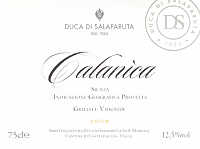
|
|
Calanica Bianco Grillo e Viognier 2009 |
|
| Duca di Salaparuta (Sicily, Italy) | |
| Grapes: Grillo, Viognier | |
| Price: € 7.00 | Score: |
| Calanica Bianco Grillo e Viognier shows an intense greenish yellow color and nuances of greenish yellow, very transparent. The nose denotes intense, clean, pleasing and refined aromas which start with hints of apple, medlar and almond followed by aromas of hawthorn, broom, pear and plum. The mouth has good correspondence to the nose, a crisp attack and however balanced by alcohol, good body, intense flavors, pleasing roundness. The finish is persistent with flavors of apple, medlar and plum. Calanica Bianco Grillo e Viognier ages in steel tanks. | |
| Food Match: Pasta and risotto with fish and crustaceans, Broiled crustaceans, Sauteed fish | |
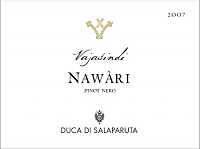
|
|
Vajasindi Nawàri 2007 |
|
| Duca di Salaparuta (Sicily, Italy) | |
| Grapes: Pinot Noir | |
| Price: € 24.00 | Score: |
| Vajasindi Nawàri shows a brilliant ruby red color and nuances of garnet red, moderate transparency. The nose reveals intense, clean, pleasing and refined aromas which start with hints of cherry, plum and blueberry followed by aromas of raspberry, vanilla, cyclamen, cocoa, tobacco, pink pepper and mineral. The mouth has good correspondence to the nose, a slightly tannic attack and however balanced by alcohol, good body, intense flavors, pleasing crispness. The finish is persistent with flavors of cherry, plum and raspberry. Vajasindi Nawàri ages for 12 months in barrique followed by at least 6 months of aging in bottle. | |
| Food Match: Roasted meat, Stewed and braised meat with mushrooms, Hard cheese | |
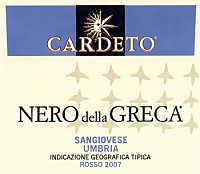
|
|
Nero della Greca 2007 |
|
| Cardeto (Umbria, Italy) | |
| Grapes: Sangiovese | |
| Price: € 12.00 | Score: |
| Nero della Greca shows an intense ruby red color and nuances of ruby red, little transparency. The nose denotes intense, clean, pleasing and refined aromas that start with hints of black cherry, blackberry and plum followed by aromas of violet, blueberry, vanilla, tobacco, chocolate, licorice and menthol. The mouth has good correspondence to the nose, a tannic attack and however balanced by alcohol, good body, intense flavors, agreeable. The finish is persistent with flavors of black cherry, blackberry and plum. Nero della Greca ages for 12 months in barrique. | |
| Food Match: Broiled meat and barbecue, Roasted meat, Braised and stewed meat | |
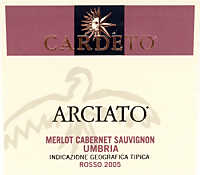
|
|
Arciato 2005 |
|
| Cardeto (Umbria, Italy) | |
| Grapes: Merlot (55%), Cabernet Sauvignon (45%) | |
| Price: € 12.00 | Score: |
| Arciato shows an intense ruby red color and nuances of ruby red, little transparency. The nose denotes intense, clean, pleasing and refined aromas which start with hints of black currant, black cherry and plum followed by aromas of blueberry, violet, vanilla, tobacco, cinnamon, chocolate and eucalyptus. The mouth has good correspondence to the nose, a tannic attack and however balanced by alcohol, good body, intense flavors, agreeable. The finish is persistent with flavors of black currant, black cherry and plum. Arciato ages for 12 months in barrique. | |
| Food Match: Roasted meat, Stewed and braised meat, Hard cheese | |

|
|
Barbera d'Asti La Tranquilla 2008 |
|
| Carussin (Piedmont, Italy) | |
| Grapes: Barbera | |
| Price: € 10.80 | Score: |
| Barbera d'Asti La Tranquilla shows a brilliant ruby red color and nuances of ruby red, little transparency. The nose denotes intense, clean, pleasing and refined aromas which start with hints of cherry, plum and violet followed by aromas of blueberry, raspberry, vanilla and menthol. The mouth has good correspondence to the nose, a slightly tannic attack and however balanced by alcohol, good body, intense flavors, pleasing crispness. The finish is persistent with flavors of cherry, plum and raspberry. Barbera d'Asti La Tranquilla ages in cask. | |
| Food Match: Pasta with meat and mushrooms, Broiled meat and barbecue, Hard cheese | |
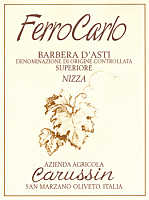
|
|
Barbera d'Asti Superiore Nizza Ferro Carlo 2007 |
|
| Carussin (Piedmont, Italy) | |
| Grapes: Barbera | |
| Price: € 18.00 | Score: |
| Barbera d'Asti Superiore Nizza Ferro Carlo shows an intense ruby red color and nuances of ruby red, little transparency. The nose reveals intense, clean, pleasing and refined aromas which start with hints of cherry, plum and dried violet followed by aromas of raspberry, vanilla, blackberry, tobacco, cocoa, leather and menthol. The mouth has good correspondence to the nose, a tannic attack and however balanced by alcohol, good body, intense flavors, pleasing crispness. The finish is persistent with flavors of cherry, plum and raspberry. Barbera d'Asti Superiore Nizza Ferro Carlo ages for 18 months in cask and in barrique. | |
| Food Match: Roasted meat, Broiled meat and barbecue, Stewed and braised meat, Hard cheese | |
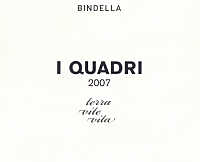
|
|
Vino Nobile di Montepulciano I Quadri 2007 |
|
| Bindella (Tuscany, Italy) | |
| Grapes: Sangiovese | |
| Price: € 22.00 | Score: |
| Vino Nobile di Montepulciano I Quadri shows a brilliant ruby red color and nuances of ruby red, moderate transparency. The nose reveals intense, clean, pleasing, refined and elegant aromas which start with hints of black cherry, plum and violet followed by aromas of blueberry, blackberry, vanilla, tobacco, cocoa, mace, leather and menthol. The mouth has good correspondence to the nose, a tannic attack and however balanced by alcohol, full body, intense flavors, agreeable. The finish is persistent with flavors of black cherry, plum and blackberry. Vino Nobile di Montepulciano I Quadri ages for 18 months in cask followed by 12 months of aging in bottle. | |
| Food Match: Game, Stewed and braised meat, Roasted meat, Hard cheese | |
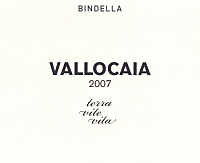
|
|
Vallocaia 2007 |
|
| Bindella (Tuscany, Italy) | |
| Grapes: Syrah (50%), Sangiovese (28%), Cabernet Sauvignon (22%) | |
| Price: € 26.00 | Score: |
| Vallocaia shows an intense ruby red color and nuances of ruby red, little transparency. The nose reveals intense, clean, pleasing, refined and elegant aroma that start with hints of black cherry, plum and black currant followed by aromas of blueberry, violet, vanilla, chocolate, tobacco, pink pepper, mace and eucalyptus. The mouth has good correspondence to the nose, a tannic attack and however balanced by alcohol, full body, intense flavors, agreeable. The finish is persistent with flavors of black cherry, plum and black currant. Vallocaia ages in cask for 18 months followed by 12 months of aging in bottle. | |
| Food Match: Game, Roasted meat, Stewed and braised meat, Hard cheese | |
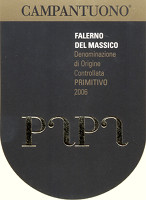
|
|
Falerno del Massico Primitivo Campantuono 2006 |
|
| Gennaro Papa (Campania, Italy) | |
| Grapes: Primitivo | |
| Price: € 22.00 | Score: |
| Falerno del Massico Primitivo Campantuono shows an intense ruby red color and nuances of ruby red, little transparency. The nose reveals intense, clean, pleasing, refined and elegant aromas which start with hints of blackberry, black cherry and plum followed by aromas of violet, vanilla, tobacco, chocolate, cinnamon, pink pepper, leather and menthol. The mouth has good correspondence to the nose, a tannic attack and however balanced by alcohol, full body, intense flavors, pleasing roundness. The finish is persistent with flavors of blackberry, plum and black cherry. Falerno del Massico Primitivo Campantuono ferments and ages in barrique for 13 months. | |
| Food Match: Game, Roasted meat, Stewed and braised meat, Hard cheese | |
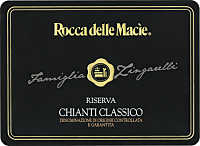
|
|
Chianti Classico Riserva 2007 |
|
| Rocca delle Macie (Tuscany, Italy) | |
| Grapes: Sangiovese (90%), Cabernet Sauvignon (5%), Merlot (5%) | |
| Price: € 19.00 | Score: |
| Chianti Classico Riserva shows an intense ruby red color and nuances of garnet red, little transparency. The nose denotes intense, clean, pleasing and refined aromas which start with hints of violet, blueberry, blackberry, vanilla, tobacco, chocolate and menthol. The mouth has good correspondence to the nose, a tannic attack and however balanced by alcohol, good body, intense flavors, agreeable. The finish is persistent with flavors of black cherry, plum and black currant. Chianti Classico Riserva ages for about 2 years in cask followed by at least 3 months of aging in bottle. | |
| Food Match: Broiled meat and barbecue, Roasted meat, Stewed and braised meat with mushrooms | |
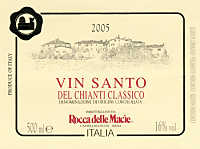
|
|
Vin Santo del Chianti Classico 2005 |
|
| Rocca delle Macie (Tuscany, Italy) | |
| Grapes: Trebbiano Toscano, Malvasia Bianca | |
| Price: € 18.00 - 500ml | Score: |
| This Vin Santo del Chianti Classico shows a brilliant amber yellow color and nuances of amber yellow, transparent. The nose reveals intense, clean, pleasing and refined aromas which start with hints of raisin, dried fig and almond followed by aromas of dried apricot, quince jam, vanilla, tobacco, honey, candied fruits, caramel and nail polish. The mouth has good correspondence to the nose, a sweet and round attack, however balanced by alcohol, good body, intense flavors, pleasing crispness. The finish is persistent with flavors of raisin, dried fig and almond. This Vin Santo del Chianti Classico ages for at least 3 years in small barrels. | |
| Food Match: Dried fruit tarts, Hard cheese | |
|
||||||||
|
DiWineTaste Polls
|
| |||||||
Privacy Policy | |||||||


| Copyright © 2002-2024 Antonello Biancalana, DiWineTaste - All rights reserved |
| All rights reserved under international copyright conventions. No part of this publication and of this WEB site may be
reproduced or utilized in any form or by any means, electronic or mechanical, without permission in writing from DiWineTaste. |